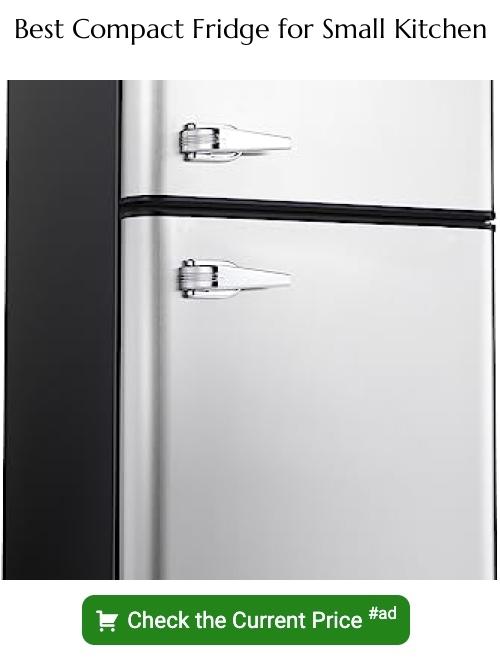Last updated on
Discover the secrets to seamlessly incorporating a fridge into your compact kitchen without compromising aesthetics or functionality.
Fitting a fridge in a small kitchen can be a daunting task, especially if you’re someone who loves to cook and needs ample space to store your ingredients. But don’t worry, with the right approach and some clever tricks, you can make it work! In this article, we’ll share some practical tips on how to fit a fridge in a small kitchen without compromising on style or functionality.
From choosing the right size and type of fridge to creative storage solutions, we’ve got you covered. So let’s dive in!
What's Inside
Measure Your Kitchen Space

The first step to fitting a fridge in your small kitchen is to measure the available space. This will help you determine the maximum size of fridge that can fit into your kitchen without overcrowding it.
Start by measuring the height, width, and depth of the area where you plan to place your fridge.
It’s important to consider not only how much space is available but also how accessible it is. Make sure there’s enough clearance around all sides of the refrigerator for easy opening and closing of doors or drawers.
Once you have these measurements, compare them with those provided by different manufacturers when shopping for a new refrigerator. Keep in mind that some fridges may require additional clearance due to ventilation needs or door swing direction.
Determine Fridge Capacity Needs
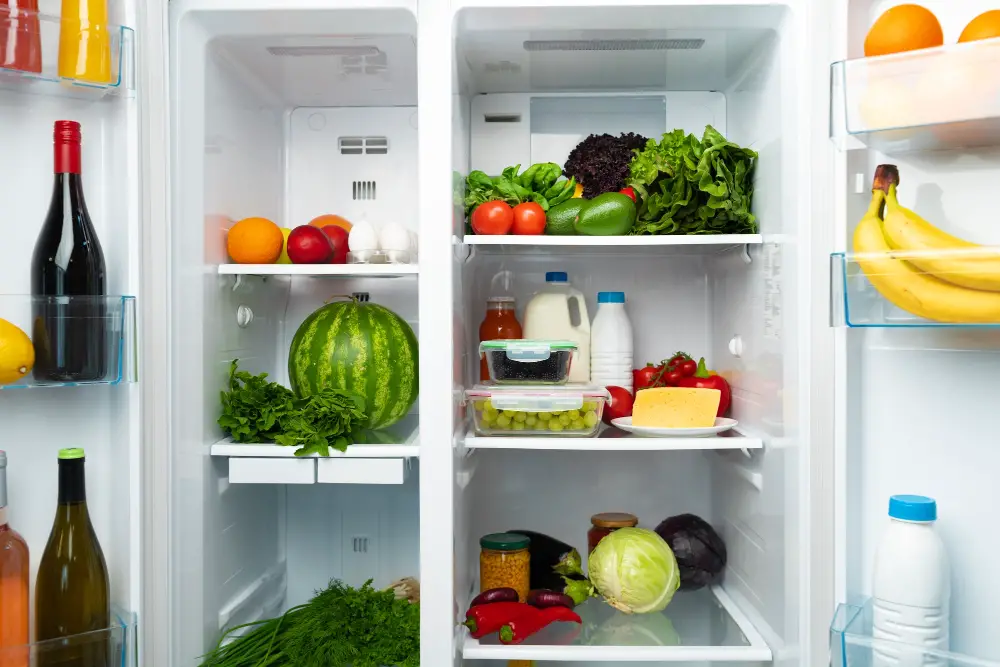
This will depend on several factors, such as the size of your family, how often you cook and shop for groceries, and whether or not you entertain guests frequently. It’s important to choose a fridge that can accommodate all of your food items without overcrowding it or leaving too much empty space.
To determine the right capacity for your needs, consider measuring out how much space in cubic feet each member of your household requires. A good rule of thumb is to allow 4-6 cubic feet per adult person and 2-3 cubic feet per child.
Another factor to keep in mind when determining fridge capacity needs is what types of foods you typically store. If you buy lots of fresh produce that takes up more room than pre-packaged meals or frozen goods then this should be taken into account when choosing a refrigerator model with enough storage options.
Choose the Right Fridge Style

First and foremost, think about the size of your kitchen and how much space you have available for a fridge. If you have limited floor space but plenty of vertical room, then a tall or slimline model might be ideal.
Another factor to consider is whether you want an integrated or freestanding fridge. Integrated fridges are designed to blend seamlessly into your cabinetry, creating a sleek and streamlined look that’s perfect if aesthetics are important to you.
On the other hand, freestanding fridges can add character and personality to your kitchen with their unique designs.
Fridge Types for Small Kitchens

The type of fridge you choose can also make a big difference in terms of functionality and aesthetics. Here are some popular types of fridges that work well in small kitchens:
1. Top-Freezer Fridge: This classic style features a freezer compartment on top and a refrigerator below, making it an excellent option for those who need more freezer space than bottom-freezer models offer.
2. Bottom-Freezer Fridge: With its freezer compartment located at the bottom, this type of fridge allows easy access to frequently used items without having to bend down too much.
3. French Door Fridge: A French door model has two doors that open outwards from the center with side-by-side compartments above and below them; this design maximizes storage capacity while minimizing floor space usage.
4. Side-By-Side Fridge: This style splits your refrigerator into two vertical sections – one side is dedicated entirely to fresh food storage while another houses frozen goods – which makes organizing easier but may require more width than other options.
5.Counter-depth Fridges : These refrigerators are designed specifically for smaller spaces as they have shallower depths compared with standard models; they blend seamlessly into cabinetry or walls giving an integrated look.
Slim and Slender Options
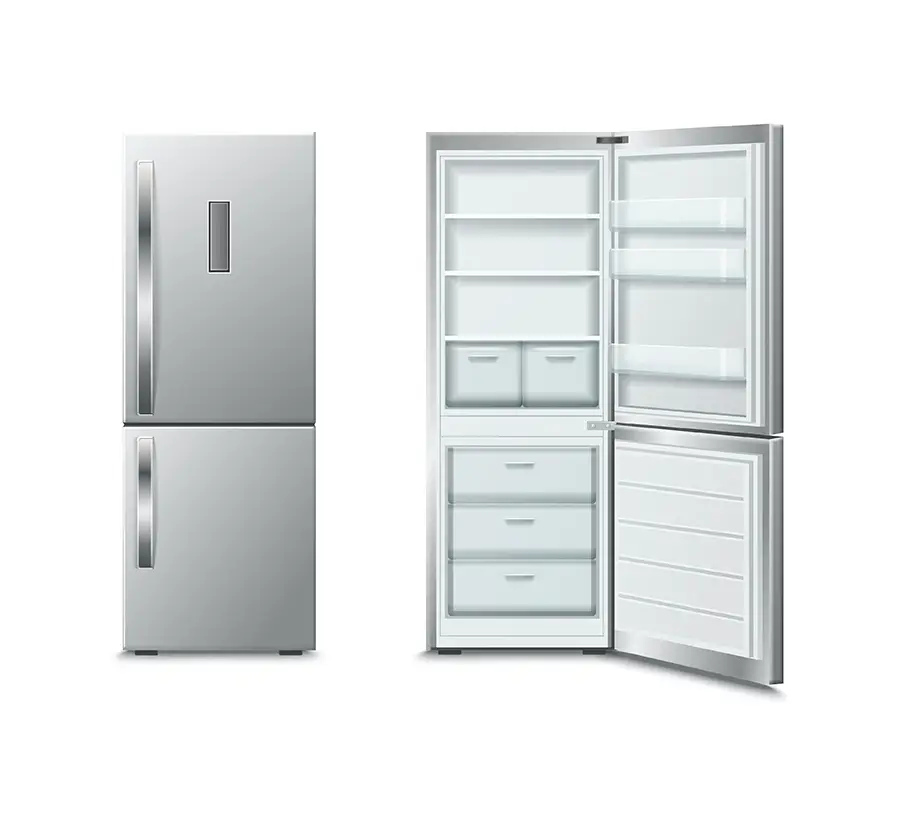
These fridges are designed specifically for compact spaces and can be as narrow as 24 inches wide. They may not have the same capacity as larger models, but they make up for it in style and convenience.
One popular option is a counter-depth fridge, which sits flush with your cabinets to create a seamless look. Another option is a French door refrigerator with bottom freezer drawers that slide out like drawers instead of swinging open like doors.
When choosing slim or slender fridges, pay attention to the dimensions of both the appliance itself and its interior storage space. You want to ensure it has enough room for all your groceries without feeling cramped or cluttered.
Matching Fridge Aesthetics
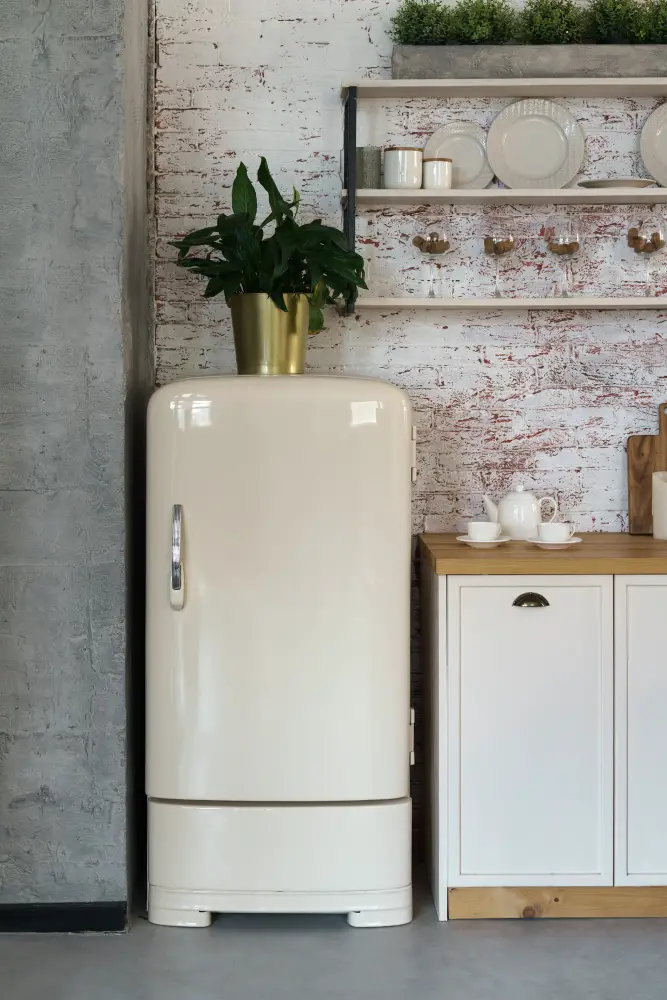
You want your fridge to blend seamlessly with the rest of your décor and not stick out like a sore thumb. One way to achieve this is by matching the color and style of your fridge with that of other appliances or cabinets in the kitchen.
If you have stainless steel appliances, consider getting a stainless steel finish for your fridge too. Alternatively, if you have wooden cabinets or countertops, opt for wood-paneled fridges that can be customized to match any type of wood.
Another option is choosing retro-style fridges that come in bold colors such as red or blue which can add some personality and character into space while still being functional.
Blending the Fridge With Your Décor
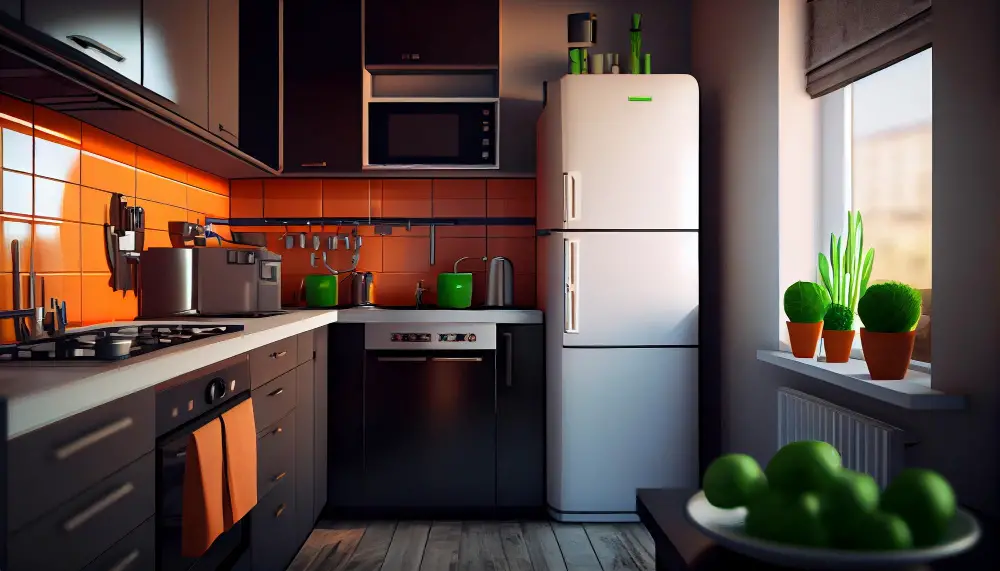
A refrigerator that stands out like a sore thumb can ruin the aesthetics of even the most well-designed kitchens. Fortunately, there are several ways to make your fridge blend seamlessly with your décor.
One way to achieve this is by choosing a color and finish that matches or complements other elements in your kitchen, such as cabinets or countertops. For instance, if you have white cabinets and marble countertops, consider getting a white or stainless steel fridge for an elegant look.
Another option is to use custom panels on built-in fridges so they match perfectly with surrounding cabinetry. This creates continuity throughout the space while also maximizing storage capacity.
You can also add decorative elements around the refrigerator area such as artwork or plants which will draw attention away from it while adding visual interest to space.
Optimize Vertical Space
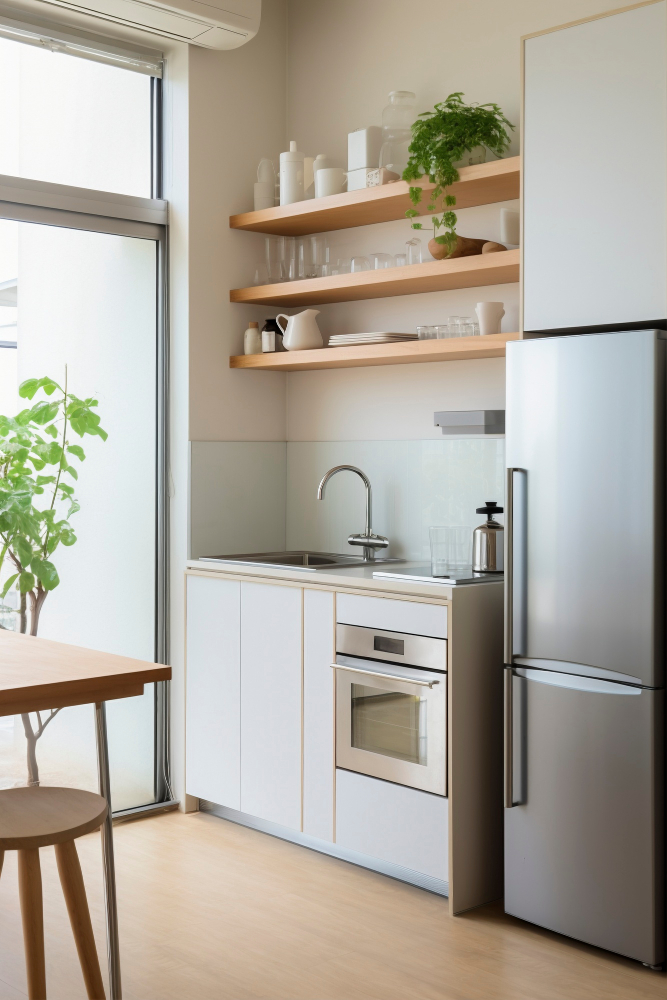
This means making use of every inch of available wall space, from floor to ceiling. One way to do this is by installing tall cabinets or shelving units that can accommodate your fridge and other kitchen appliances.
Another option is using magnetic strips or hooks on the side of your refrigerator for hanging utensils, towels, and other items you need within reach while cooking. You can also install floating shelves above your fridge for additional storage.
If you have limited floor space but high ceilings, consider investing in a slimline refrigerator with an extended height that maximizes vertical storage without taking up too much room horizontally.
Vertical Storage Solutions

By utilizing wall-mounted shelves, you can free up valuable counter and floor space while keeping your fridge within easy reach. Consider installing open shelving above or beside your fridge for storing frequently used items such as spices, oils, and utensils.
Another option is to install a magnetic strip on the side of your fridge for holding knives or other metal tools. You can also use adhesive hooks on the sides of cabinets or walls near the fridge to hang towels, pot holders, and other lightweight items.
If you have limited cabinet space in your kitchen but still need extra storage options for food items like canned goods or snacks consider investing in an over-the-door organizer that hangs from pantry doors. These organizers come with multiple pockets that allow you to store various types of foods without taking up too much room.
Incorporate Built-In Fridges
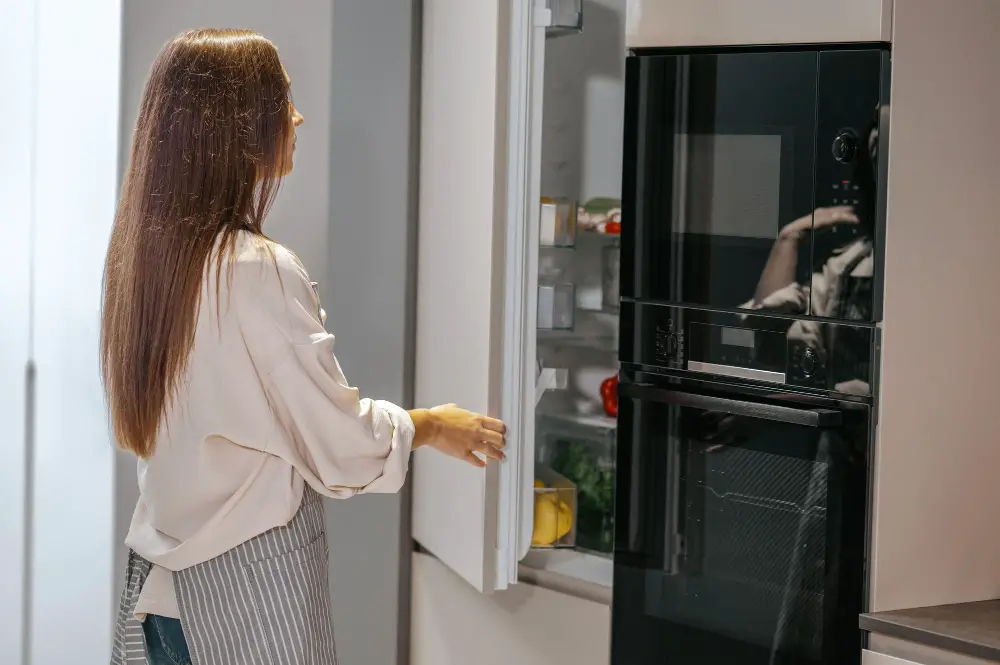
These types of fridges are designed to fit seamlessly into your kitchen cabinetry, giving your small kitchen a streamlined appearance. Built-in refrigerators come in various sizes and styles that can be customized according to your specific needs.
One popular option is the under-counter fridge which fits perfectly beneath countertops or islands without taking up too much space. Another option is an integrated fridge that blends with other cabinets in the kitchen.
When incorporating built-in fridges into small kitchens, it’s essential to consider their placement carefully. You want them positioned where they won’t obstruct movement around the room or interfere with other appliances like ovens or hobs.
Built-in Fridge Ideas

These fridges come in various sizes and styles to suit different kitchen designs. One popular option is the under-counter built-in fridge, which fits perfectly beneath your countertop and provides easy access to food items without taking up too much space.
Another idea is the tall built-in fridge that extends from floor to ceiling, providing ample storage capacity while blending with your kitchen’s décor. This type of fridge can also be customized with panels that match your cabinets or painted in a contrasting color for added visual interest.
If you have an awkward corner or unused wall space in your kitchen, consider installing a corner-built refrigerator unit that maximizes every inch of available area while adding an interesting design element.
When choosing a built-in refrigerator unit for small kitchens, it’s essential to measure carefully and select one that fits snugly into its designated spot without leaving any gaps around it. This will ensure optimal functionality and prevent heat loss due to air leaks.
Consider Under-counter Fridges
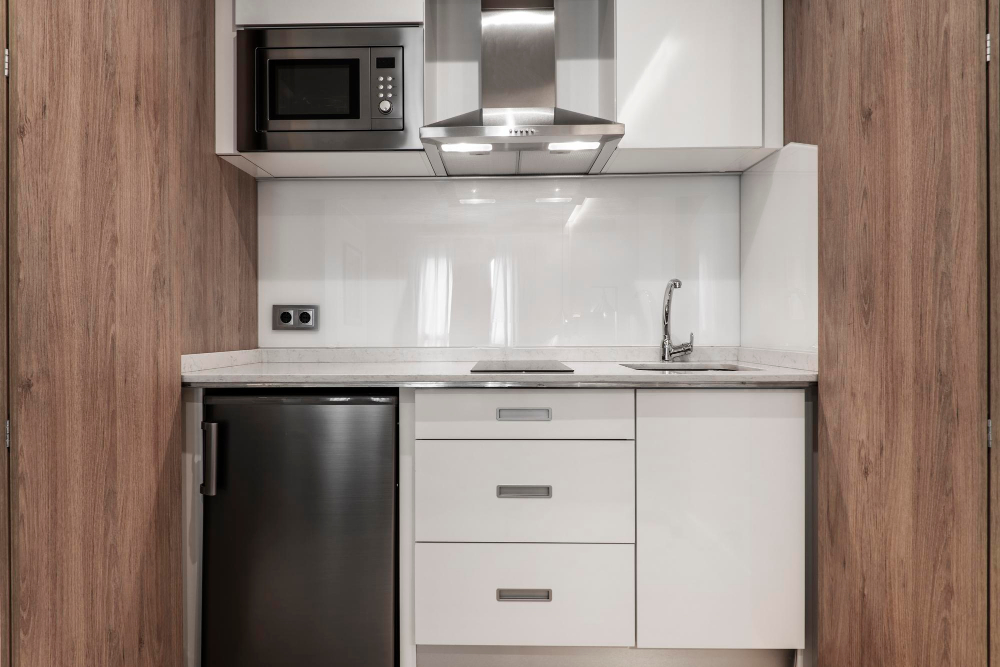
These fridges are designed to fit seamlessly into your kitchen cabinetry and can be placed below or above counters depending on your preference. They come in various sizes, so you can choose one that fits perfectly into the available space.
Under-counter fridges are ideal for small kitchens because they don’t take up valuable floor space and blend in with other appliances. They also offer easy access to food items without having to bend down like with traditional refrigerators.
When considering an under-counter fridge, make sure it has enough capacity for your needs and is energy-efficient. Also, consider its placement carefully as it should not interfere with other appliances such as ovens or hobs.
Below or Above-counter Placement
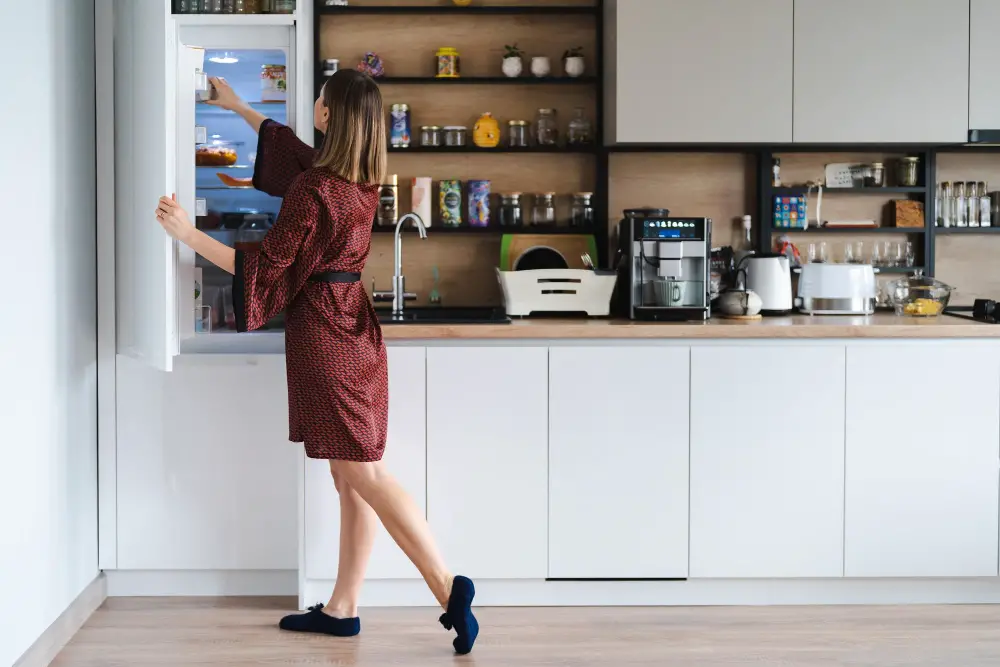
These models are designed to fit perfectly beneath your kitchen counters and blend seamlessly with the rest of your cabinetry. They come in various sizes and styles, including drawer-style options that allow you to store items at different temperatures.
Alternatively, above-counter placement can also work well if you have some extra wall space available. This option allows for easy access to the fridge without having to bend down or crouch low every time you need something from it.
When deciding between below or above-counter placement, consider factors such as ease of use and accessibility as well as how much storage space is required. Ultimately, choosing the right fridge location will depend on your specific needs and preferences.
Use Fridge-freezers Combinations
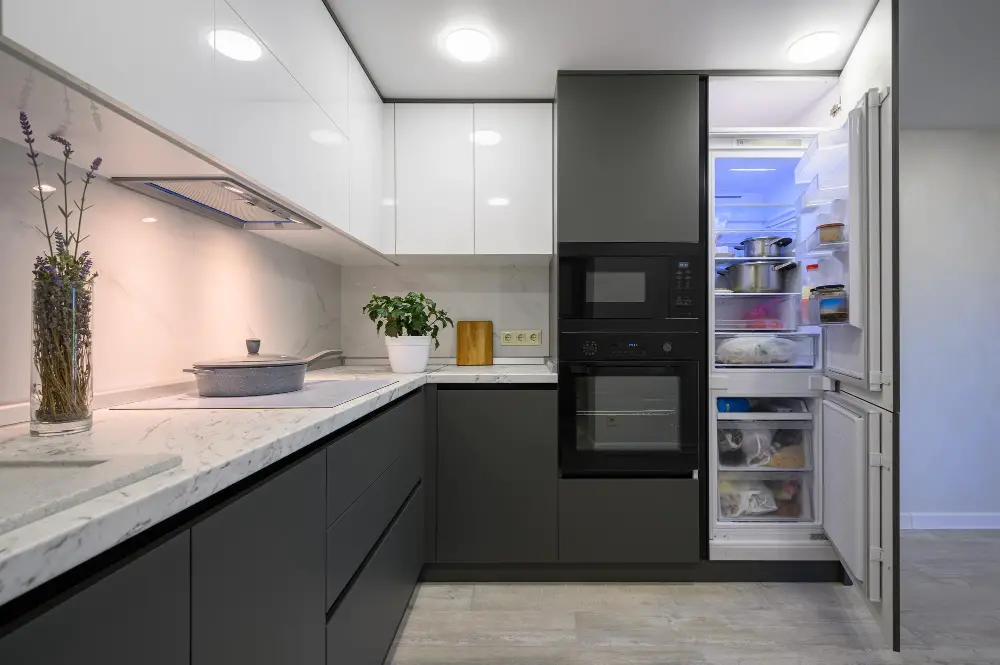
These appliances come in various sizes and styles, making them perfect for small kitchens. One of the benefits of having a combined unit is that it saves floor space by eliminating the need for two separate appliances.
When choosing your fridge-freezer combo, consider your storage needs carefully. If you tend to use more fresh produce than frozen foods, opt for models with larger refrigeration compartments than freezers or those with smaller freezer sections at the top or bottom.
Another thing to keep in mind when selecting this type of appliance is its energy efficiency rating as they can consume more electricity compared to standalone fridges or freezers. Look out for models with an A+ rating or higher as these are designed specifically to save on energy costs while still providing optimal performance.
Install a Mini Fridge

These compact appliances are ideal for storing drinks and snacks, and they can easily fit under a countertop or in a corner of your kitchen. Plus, they come in all sorts of fun colors and designs to add some personality to your space.
When installing a mini fridge, it’s important to consider its placement carefully. You’ll want it somewhere that’s easily accessible but doesn’t get in the way of other kitchen activities like cooking or cleaning up.
One option is to place it on top of an existing counter if there’s enough room. Alternatively, you could install shelves above your workspace specifically designed for holding small fridges.
Another idea is placing them inside cabinets with pull-out drawers so that when not needed can be hidden away from sight while still being functional. Whatever method you choose make sure there’s proper ventilation around the unit as overheating may cause damage over time.
Organize Fridge Contents
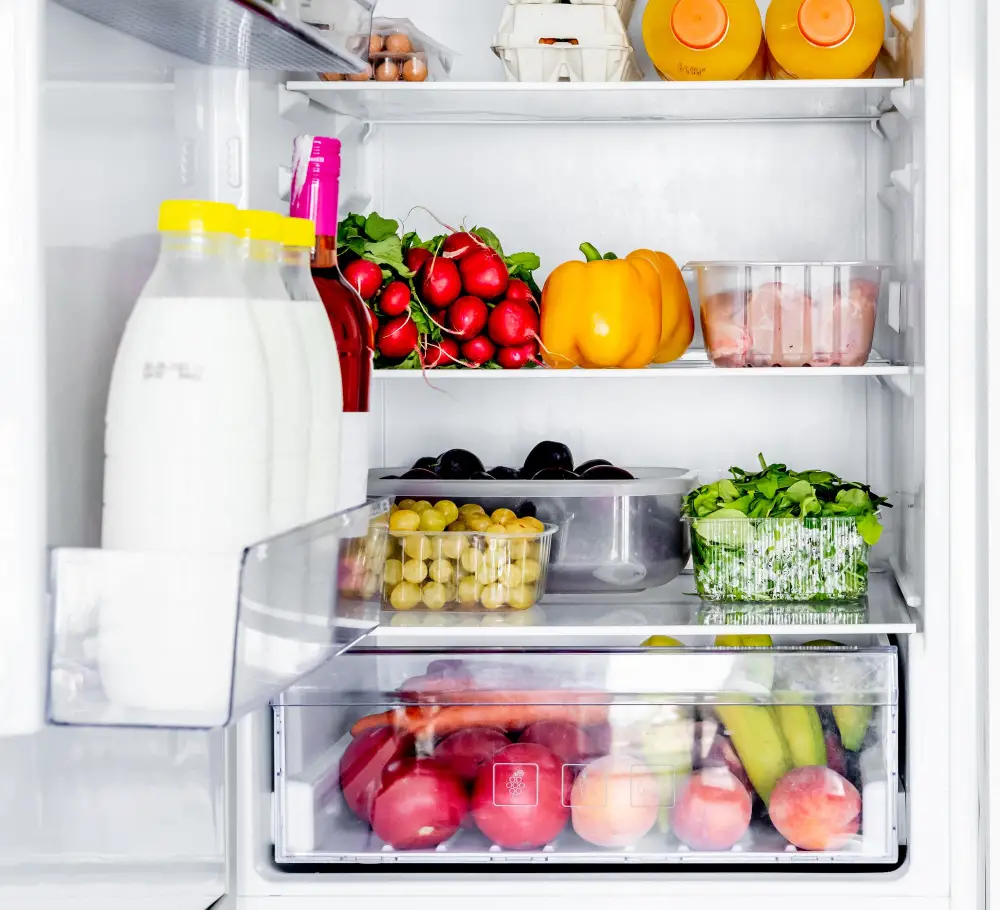
A cluttered and disorganized fridge can make it difficult to find what you need, leading to food waste and frustration. To avoid this, start by grouping similar items together in designated areas of the fridge.
For example, keep all dairy products like milk and cheese on one shelf or drawer while fruits and vegetables are stored in another.
Consider investing in clear plastic containers or bins that fit neatly into your shelves or drawers; these can help maximize space while keeping everything organized. Label each container with its contents so that everyone knows where things belong.
Another tip is to use a lazy Susan turntable for condiments such as ketchup bottles or salad dressings; this makes them easy-to-reach without having them take up too much space on a shelf.
Maximizing Fridge Efficiency
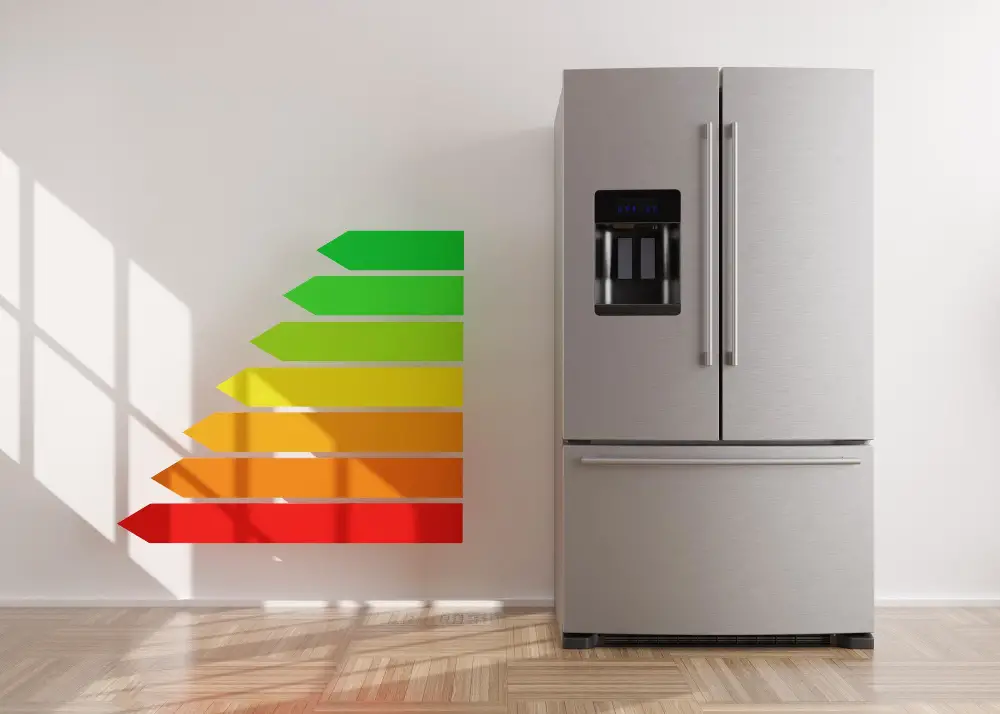
This means organizing its contents in a way that allows for easy access and reduces energy consumption. One simple trick is to keep frequently used items at eye level or in the top shelf, while less commonly used items can be stored on lower shelves or in drawers.
Another tip is to avoid overloading your fridge with too many items as this can restrict airflow and cause temperature fluctuations. It’s also important not to block air vents inside the fridge as this can affect cooling performance.
Consider investing in an energy-efficient model that has earned an Energy Star rating. These fridges use up to 40% less energy than standard models and are designed with features such as improved insulation and more efficient compressors.
Prioritizing Energy-saving Models

Not only will an energy-saving model help you save money on your electricity bills, but it’s also better for the environment. Look for fridges with high Energy Star ratings and features like automatic defrosting and adjustable temperature controls that can help reduce energy consumption.
Another way to prioritize energy efficiency is by choosing the right size of fridge that suits your needs. A larger fridge may seem like a good idea at first glance, but if you don’t need all that space, then it’s just wasting electricity.
On the other hand, if you choose too small of a refrigerator for your family’s needs then overfilling could lead to poor air circulation which would increase power usage.
Proper Oven Distance
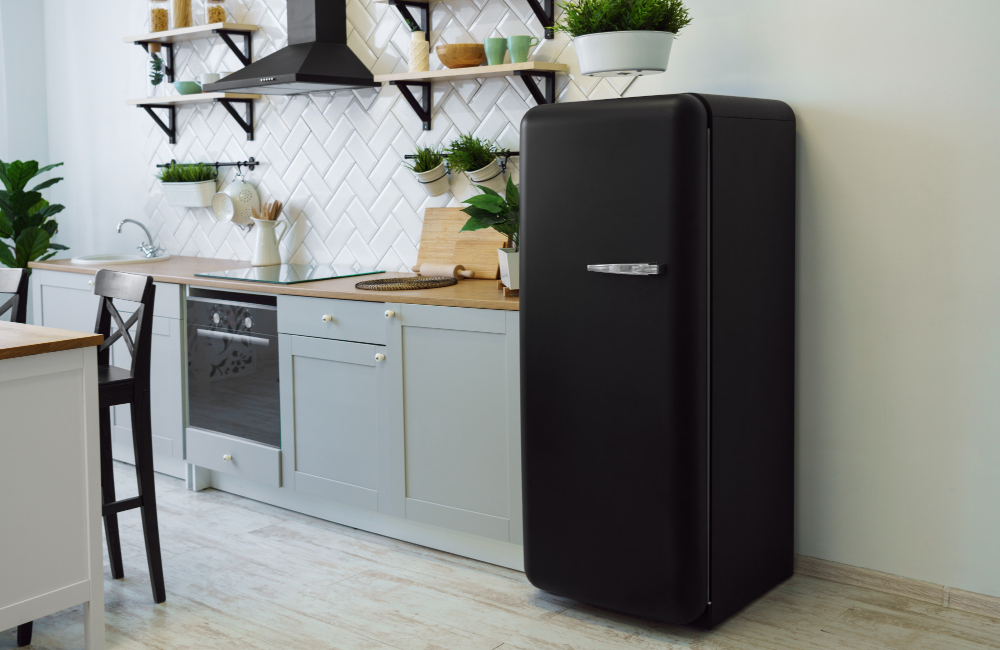
One such appliance is the oven. It’s crucial to maintain proper distance between your fridge and oven for safety reasons.
The heat generated by an oven can affect the performance of your refrigerator and even cause it to malfunction if placed too close.
The general rule of thumb is that there should be at least 15cm (6 inches) between your fridge and any heat source, including ovens or hobs. This will ensure that there’s enough ventilation around the refrigerator, allowing it to function optimally without overheating.
If you have limited space in your kitchen, consider installing a slimline or under-counter model for both appliances so they can fit comfortably side-by-side while maintaining safe distances from each other.
Stay Away From the Hob
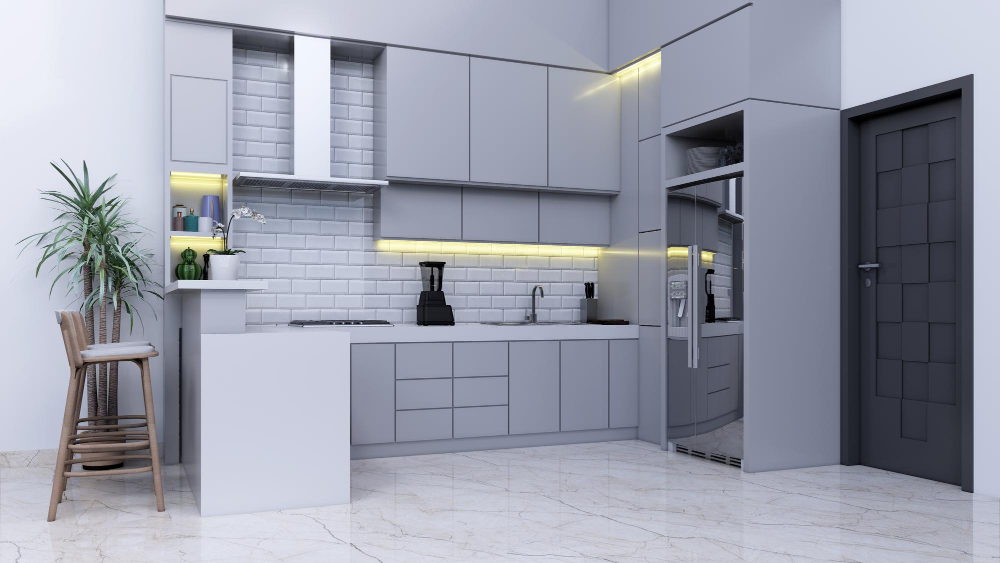
One of the most important things is ensuring that your fridge is positioned correctly and safely. This means keeping it away from any heat sources, especially the hob.
Placing your fridge too close to the hob can cause several problems. Firstly, it can affect its efficiency by making it work harder than necessary due to increased ambient temperature around the appliance.
Secondly, if you have an older model with coils at the back or on top of your refrigerator unit (as opposed to modern fridges with built-in condensers), placing them near heat sources like hobs could lead them overheating and potentially causing damage.
To avoid these issues altogether, make sure that you position your fridge as far away from any heat source as possible – ideally on another wall or opposite side of where you cook food so that they don’t interfere with each other’s operation.
By following this simple tip along with others mentioned above such as measuring space accurately and choosing appropriate storage solutions for vertical spaces; incorporating built-in fridges; considering under-counter options; using mini-fridge alternatives when needed- You’ll be able fit a functional yet stylish refrigerator into even tightest kitchens without sacrificing aesthetics or functionality!
FAQ
Where is the best place to put a fridge in the kitchen?
The best place to put a fridge in the kitchen is in the southwest corner, away from the north or east, and not close to a corner or hooked to a wall, with alternative positions being west, north, or northwest.
How do you set up appliances in a small kitchen?
To set up appliances in a small kitchen, arrange frequently used appliances on the countertop or lowest shelf of an upper cabinet, place rarely used appliances on top of the cabinets, and sell or donate never-used items.
Can a fridge be in a cabinet?
A fridge cannot be placed in a normal, unmodified cabinet as it requires proper ventilation for heat dissipation to prevent decreased performance and eventual failure.
What are some space-saving fridge designs suitable for small kitchens?
Some space-saving fridge designs suitable for small kitchens include compact or apartment-sized models, under-counter units, and slim, tall designs that optimize vertical space.
How can you maximize storage around a fridge in a limited space kitchen?
To maximize storage around a fridge in a limited space kitchen, consider using vertical storage solutions like shelving and magnetic panels, as well as utilizing the space on top of the fridge.
What factors should be considered when choosing a fridge for a small kitchen layout?
When choosing a fridge for a small kitchen layout, consider factors such as size, design, energy efficiency, and storage capacity.
